 Leading Blog | Posts by Month |
 Leading Blog | Posts by Month |
09.30.11

LeadershipNow 140: September 2011 Compilation
Posted by Michael McKinney at 03:16 PM
09.28.11

The 3 Core Elements of Delegation
Without delegation no organization can function effectively. Yet, lack of courage to delegate properly, and the knowledge of how to do it, is one of the most general causes of failure in organizations.Every time you delegate work to a teammate, three inescapable core elements of delegation are in play. Authority, responsibility, and accountability form an integrated process and must be applied by you as a unified whole. Authority Can Be Delegated As a leader, you can transfer pieces of your formal authority to another teammate when assigning a task to that person. In essence, you can deputize your teammate to take action on your behalf within the boundaries of the delegated (transferred) authority. Authority chiefly comes from the power of position. The more authority you have, the greater your ability to delegate higher-level, more meaningful and challenging tasks to others to help them learn, develop, and grow. Responsibility Cannot Be Delegated, but It Can Be Assigned As a leader, you can assign responsibility to another teammate in terms of the results that need to be achieved. However, you need to keep in mind that you only assigned responsibility to your teammate. If your teammate “fouls up the thing royally,” your manager will censure you, not your teammate. In short, you can never fully hand off any of your responsibilities to someone else. Assigned responsibility should be made in terms of the goals or results to be accomplished, not the detailed specifics for doing the job. Accountability Means Obligation Accountability is the moral compulsion felt by a teammate to meet the goals and objectives of an assigned task. As a result of accepting a task assignment, your teammate in effect gives you a promise—either expressed or implied—to do her best in carrying out the activities associated with it. Having taken on the task, your teammate is obligated to complete it, and thus is held accountable by you for the results produced. Adapted from Building Team Power: How to Unleash the Collaborative Genius of Teams for Increased Engagement, Productivity, and Results by Thomas A. Kayser
Posted by Michael McKinney at 12:09 PM
09.26.11

Leading: Sharing Accountability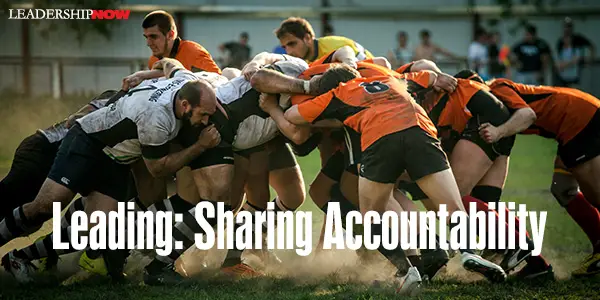
UNCERTAINTY necessitates the need for finding more wisdom within our organizations. This can only be accomplished by creating a leadership mindset throughout the entire organization. It is shared accountability. Any leader that thinks that they can do it alone is indulging their own ego. James Champy and Nitin Nohria cautioned us not to assume that no one else on the premises can match our own ambition, competence, and vision. We have to accept the fact that there are many points of wisdom within our organizations and a wise leader will engage them. Too many leaders are not accustomed to accepting input from junior members no matter how valuable it is. This creates a lack of trust and openness. The currency of leadership is relationships and a wise leader would do well to encourage input from as many sources as possible and especially not from the usual suspects. Phil Nolan, former CEO of Eir Limited, described it this way in A Time for Leadership: The concept of distributed leadership will keep you in touch with the environment. If you want to prepare people for this environment, you have to get leadership further down the organization. We generally tend to drive managing down the organization, but not leadership. Leadership needs to be the expected norm at all levels.
Posted by Michael McKinney at 12:08 PM
09.23.11

The Art of Leadership
MAX DEPREE popularized the idea that leadership is an art. So much of what a leader does cannot be objectively measured. To reduce leadership to a set of algorithms is to remove it from its context; to ignore the complexities, the contradictions, and the possibilities. Artists must deal with uncertainty, contradictions, and diversity almost by definition. Leaders need to have this capacity. Julie Burstein has created a valuable achieve of thought about art and artistry in Spark: How Creativity Works. Her book is drawn from hundreds of hours of conversations from the radio program Studio 360. Studio 360 was created to show how creativity works by talking to some of the world’s most talented people. I hope you find these artist’s thoughts on their work inspiring to you no matter where you lead. Painter Chuck Close reminds us that leadership is about results. You will be judged on your accomplishments. So, you have to get on with it. Inspiration is for amateurs, and the rest of us just show up and get to work. But so much of it comes out of the process … if you try to preconceive everything you do and conceptualize it, you’re gonna do the same thing over and over. If, however, you just get busy and things occur to you in the process, you make the rules and therefore you can break them. Sound designer Ben Burtt talks about the importance of being what Saul Bellow once called a “first class noticer.” We need to observe more, to listen closer, and be open to surprises. Many of the most useful sounds I’ve used were discoveries made by accident. I would be going about some other business but then hear something interesting. I learned to keep my recorder nearby. I’d grab a sound that caught my attention. Even if you don’t know what it’s going to be. If something interests me, if something is provocative in some way, if it has a sense of suspense to it, or power, or humor, then it’s worth gathering and stockpiling until I find a place in a movie to use it. I have a big collection and it’s always growing. I’m probably always listening to what goes on around me, whether I want to or not. Being a leader means stretching yourself and your team; getting out of your comfort zone; becoming more than is expected. Choreographer Elizabeth Streb knows the importance of taking a risk. “What the audience sees is somebody taking their physical entity and just stretching it beyond their comfort.” It’s not that the dancers want to put themselves in harm’s way, she explained. “It’s the other way around. To effect certain actions onstsage, it’s necessary to put yourself in harm’s way. I think it’s a means to an end. If you don’t allow yourself to get out of your comfort zone, then you can’t discover new physical territory. And it comes with that territory that here’s going to be certain things that scare you. You’re going to try to locate them, and unravel them, and go further and further and further toward something that you couldn’t imagine doing physically prior to that initial investigation. Getting out and discovering new territory is how leaders define choices. And some days it’s easier than others says Streb. We are all normal people and we’re scared of similar things that other people are scared of. We just have an appetite to dig into them and conquer them on some level. And then the fear switches…. All of a sudden, on a Wednesday, you’re just terrified, you can’t do it. There’s no accounting for those shifts in fear. The late poet Stanley Kunitz reminds us that like most things in life, leadership requires pruning; eliminating those things that distract and detract. Creative destruction. It’s an art. As with the making of a poem, so much of the effort is to get rid of all the excess, and at the same time be certain you are not ridding the poem of its essence. While it’s in a leader’s DNA to shake-up the status quo, it has to be done with the past in mind. The past is not all bad, and the future is not all better. The past can serve as an anchor, but it can also provide depth to the future. Director Alexander Payne points to the importance of our past. We forget our past do quickly, but we need it for a sense of identity. For some idea of who we are. Photographer David Plowden would agree. I fear that we are eradicating the evidence of our past accomplishments so quickly that in time we may well lose the sense of who we are. Of course, leaders can’t do it alone. We are made better by the teams we build and the people we associate with. It’s how we learn and grow. Robert Plant speaks of his collaboration with Alison Krauss on the album Raising Sand: Something had to happen for me where I was going to learn something. I wanted to work with people who were going to push me, and not threaten me but challenge my whole capacity to be a really proper singer. Not just a one-trick pony, but somebody who could actually modify and adapt and get into some kind of dreamscape. As it happens, this is the combination that transpired, and it couldn’t be better, really. If our insecurities get in our way and we exclude those with differing opinions or those who might be critical of what we are doing, we attenuate our leadership potential. We narrow our perspective. Architect’s Denise Scott Brown and Robert Venturi are a married couple and partners in work. They value each other’s criticism in the creative process. Denise explains: We jump-start the design process by batting ideas around between us. Our ideas bounce back and forth….This questioning intensifies the process and speeds it up. Self-criticism might eventually have led him to the same position, but my questions and suggestions push him and he gets there faster. Of course, he does the same for me. “Intensifies the process and speeds it up.” That’s a good way to think about it. As in any creative endeavor—and each of us is a creative endeavor—we need to be who we really are and not a reflection of someone we admire. Robert Venturi’s respect for the past doesn’t mean recreating it. Our heroes should serve as a reference point, but not a straightjacket. Reference to the historical past can enrich architecture; copying stultifies it. When it isn’t working you have to have the courage to rework it or even start over if necessary. Novelist John Irving once took an 800-page book back from the publisher because it wasn’t right. It was such an enormous undertaking to rewrite this book from the first person to a third-person novel. Took me nine months, all by hand. I hope I come to that conclusion sooner if it happens again. But when it is working, Chuck Close says you should celebrate! Every time I finish a painting, I play Aretha Franklin full blast, from start to finish, and I usually sing along with her as my celebratory end to each painting. Author and producer Julie Burstein says that we should “never miss this essential step of celebrating the accomplishment.” The work now, she concludes, is for each of us to create our own stories. 
Posted by Michael McKinney at 03:03 PM
09.22.11

5 Leadership Lessons: Good Strategy, Bad Strategy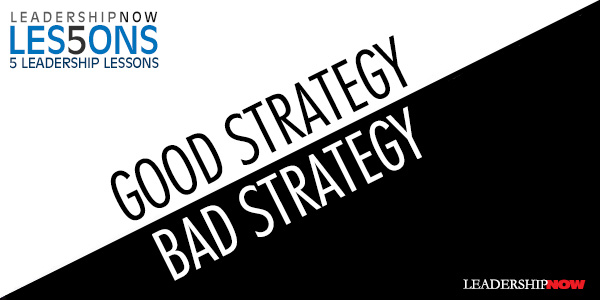
RICHARD RUMELT has written an insightful book on developing the ability to identify and develop good strategy. Good Strategy, Bad Strategy is obviously the result of decades of practice developing strategy and the many case studies and classroom interactions made it personal and very readable. We’ve all been there. The big conference room as the lights dim and the PowerPoint slides begin. We sit attentively as the leader steps to the podium to tell us something like: “Going forward we will attain global leadership in our markets, increase revenues and profits ten percent, rationalize our supply chain and eat the competition’s lunch by taking huge chunks of market share—all based on one of the world’s most highly talented workforces for whom success is never quitting until you win.” When it comes to strategy, we have gotten off-track into thinking that fluffy platitudes, goals, motivational slogans, and wishful thinking are the same thing as strategy. As a result, we don’t get the intended results. “Bad strategy,” says Rumelt, occurs when there is bad doctrine, when hard choices are avoided, and/or when leaders are unwilling or unable to define and explain the nature of the challenge. Here are some key ideas from this classic on strategy:

Posted by Michael McKinney at 06:49 PM
09.21.11

The Four Hallmarks of Bad Strategy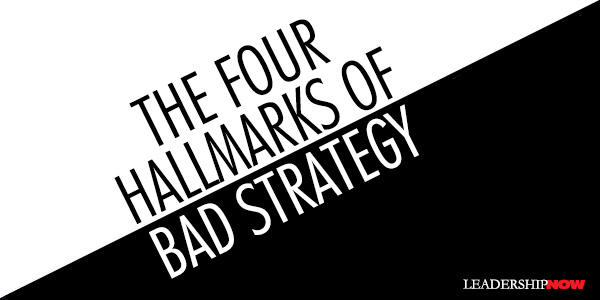
STRATEGY expert and author of Good Strategy, Bad Strategy, Richard Rumelt says that bad strategy “grows out of specific misconceptions and leadership dysfunctions.” In short, it is goals and not action. “It assumes that goals are all you need. It puts forward strategic objectives that are incoherent and, sometimes, totally impracticable. It uses high-sounding words and phrases to hide these failings.” To detect a bad strategy, Rumelt suggests looking for one or more of its major hallmarks: Fluff. Fluff is a form of gibberish masquerading as strategic concepts or arguments. It uses “Sunday” words (words that are inflated and unnecessarily abstruse) and apparently esoteric concepts to create the illusion of high-level thinking. Make it simple. Failure to face the challenge. Bad strategy fails to recognize or define the challenge. When you cannot define the challenge, you cannot evaluate a strategy or improve it. If you fail to identify and analyze the obstacles, you don’t have a strategy. Instead, you have either a stretch goal, a budget, or a list of things you wish would happen. Mistaking goals for strategy. Many bad strategies are just statements of desire rather than plans for overcoming obstacles. Bad strategy is long on goals and short on policy or action. Strategic objectives should address a specific process or accomplishment, such as halving the time it takes to respond to a customer or getting work from several Fortune 500 corporations. An excerpt from Rumelt’s response to a client that had a “strategy” that was long on goals and short on actions, is instructive: If you continue down the road you are on you will be counting on motivation to move the company forward. I cannot honestly recommend that as a way forward because competition is not just a battle of wills; it is also a competition over insights and competencies. My judgment is that motivation, by itself, will not give this company enough of an edge to achieve your goals. He explained that “when a company makes the kind of jump in performance your plan envisions, there is usually a key strength you are building on or a change in the industry that opens up new opportunities.” Bad strategic objectives. A strategic objective is set by a leader as a means to an end. Strategic objectives are “bad” when they fail to address critical issues or when they are impracticable. The purpose of good strategy is to offer a potentially achievable way of surmounting a key challenge. If the leader’s strategic objectives are just as difficult to accomplish as the original challenge, there has been little value added by the strategy. 
Posted by Michael McKinney at 01:52 PM
09.20.11

Why Are You on Twitter?For those looking to do more with Twitter than just using it to exchange information, Claire Diaz Ortiz, who leads social innovation, philanthropy, and causes at Twitter, has written Twitter for Good: Change the World, One Tweet at a Time to do just that.Claire says that Twitter is effective as a tool to coalesce your message, make a difference and create a movement. She has developed a framework—not surprisingly called T.W.E.E.T.—to help you build and effectively promote cause-based campaigns. Target. Why are you on Twitter? The three most common targets or goals are:, information accounts, personalized accounts, and fundraising accounts. Which one you choose sets the tone of your tweets. Claire recommends choosing a personalized account if “you do not have a dedicated staff member who can devote a set amount of time to finding and culling important information about your cause.” Write. The important thing is to get going without over editing. Fail fast. Who should write the Tweets? “The audience is savvy, and users who are not authentic are drowned out and their audience stops listening.” How often should I Tweet? Claire says that’s a highly contested answer. She offers a host of answers from Twitter “experts.” You’re sure to find an answer and rational that you can be comfortable with. Engage. Connect with others so you’re not tweeting in a bubble or you won’t get your organization where you need it to be. “Connecting your Tweets with existing relevant information that people are already viewing on Twitter—or making your own Tweets the relevant information that others are looking for—should be your goal.” Use #hashtags to identify your Tweets as part of a group of like-minded Tweets. Use lists to follow the relevant Tweets of others—even if you are not following them. Retweet but fill your timeline with them. She notes, “If one follower retweets every Tweet your organization writes, their recommendation for you holds less weight.” Explore. Find new people. Twitter is about relationships. Track. See how it’s working by tracking your progress. Claire offers a list of over 30 potential points to measure to see if you are getting noticed. Claire writes, “Learning to use Twitter well is not a science, but an ongoing lesson.” Fail fast and explore. More information can be found on the web at: hope140.org and Twitter4Good You can find Claire at ClaireDiazOrtiz.com or via @claired on Twitter. And yes, you can find us (me) on Twitter via @leadershipnow.
Posted by Michael McKinney at 10:18 PM
09.19.11

Hypocrisy Isn’t Going to Get You There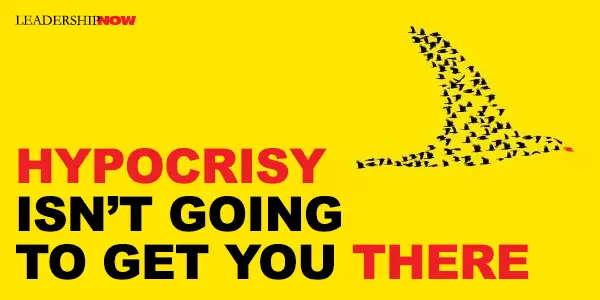
IF you’ve ever asked yourself, “What’s the matter with them? Why don’t they get it?” or said, “I feel like I am alone here,” maybe they are listening more to your actions than your words. Culture explains how things really work. Culture reflects practical values—values that will get you through the day regardless of what you say you believe. When it comes to preaching values, too many leaders are just talking heads. Preach change, demonstrate status quo. Changing culture in an organization is often difficult because leaders make it so. A culture that does not resemble your stated values reflects a lack of ownership and accountability to those values. A value that is meant for “them” but not lived-out in the behavior of and choices made by the leadership, will never become part of the organizational culture. Culture is formed by the choices we make, not the lecture we give. In Too Many Bosses, Too Few Leaders, Rajeev Peshawaria suggests three steps to cultural change: • Define the desired culture. Articulate a set of behavior guidelines for everyone to follow.
In this discussion he makes three statements that are worth reflecting on: Leaders should use every opportunity to exhibit guidelines or values in their own behavior. Are you modeling the behavior you want to see in others? Senior leaders of the company routinely showed up at these training sessions to show employees how important the values and brand were. Are you excusing yourself from what you expect others to be doing? In sharp contrast, another client told me to design the session in such a way that it did not rely too heavily on the executive team’s presence. He argued that the senior team was already under a lot of pressure, and that this would be a huge time commitment for them. I could not believe my ears. After all, as leaders, what do you spend time on if not aligning your organization’s culture with your vision and strategy? Do you live by a different set of rules? Sometimes this is difficult to see in yourself, so asking a trusted friend if there is a disconnect between your words and your behavior is helpful. As a leader, it is too easy to think of yourself as the exception. “I’m busy.” “They don’t have to deal with what I am dealing with.” “This is for them, I don’t need it. When a leader’s behavior conforms to their talk, there is a connective quality formed that is worthy of trust and attention. If we live our values we can create radical change.

Posted by Michael McKinney at 07:07 AM
09.16.11

Too Many Bosses, Too Few LeadersRajeev Peshawaria says ironically, even though leadership hasn’t changed, we have Too Many Bosses, Too Few Leaders. The difference between mere bosses and leaders is that “leaders find the energy to stay on and fight, and energize others around them, while nonleaders give up.”“Superior leadership requires incredible amounts of emotional energy—the power to stay the course despite the most formidable of obstacles.” This energy comes from discovering your purpose and values. One of the biggest reasons we have many poor leaders is that too many of them get into leadership for the wrong reasons—personal fame, fortune or glory—or are given positions based on competence alone. Peshawaria cautions that “accepting a leadership position without carefully considering what you really want for yourself and for the people around you is a very dangerous proposition.” Real leadership is not easy or glamorous, but before you make the decision to lead, you should ask yourself six questions:
As a leader you need to focus on what he calls brains, bones, and nerves or setting direction, execution, and organizational culture. The trick of course is staying focused on these issues and not becoming distracted with all of the work you should be delegating. To lead, says Peshawaria, “leaders must first uncover their own sources of leadership energy—their purpose and values—then enlist a few co-leaders and align their energy toward a common purpose. Finally, the leader and her co-workers must galvanize the energy of the rest of the organization by shaping and managing the brains, bones, and nerves of the enterprise.” In his view then, leadership development programs should help participants to become more self-aware—who they are and what they want. Peshawaria notes IMD Switzerland professor George Kohlrieser’s thought that “when development focuses too much on presenting the ‘how-to’s,’ the result is not deep enough to change the inner life of a leader.” For the most part, most leaders know enough to lead, what is often lacking is the emotional intelligence to use it appropriately. In light of the rapidly changing world, Peshawaria raises an important question: Does it still make sense to identify a few, anoint them as high potentials, and invest disproportionately in their development? As leaders, we are not good stewards of people if we don’t give everyone a “similar development diet” and let the “cream rise to the top on its own. Peshawaria asks, “What if the world changes in ways that require a totally different type of potential in five years compared with the benchmarks used to identify today’s high potentials? What about late bloomers—those who may not show early brilliance, but might become very valuable later on? And what about the negative impact on the morale of those not chosen as high potentials? It might be time to rethink the ‘best practice’ of identifying and developing a pool of high potentials.” Amen. Then too, we also might want to rethink what it means to be a leader and stop developing functional leaders and instead develop true leaders that can lead in changing contexts. That’s an entirely different focus.
Posted by Michael McKinney at 08:01 AM
09.14.11

Advocacy: How to Champion Ideas and Influence Others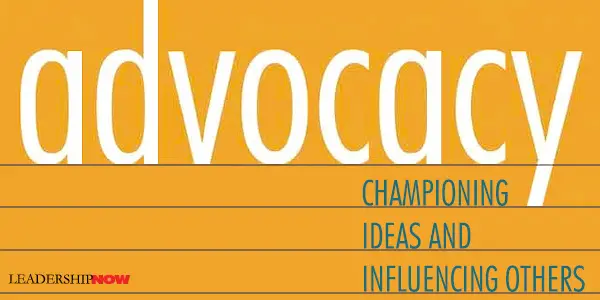
EVEN a great idea can be stopped. An idea is like play. It needs a good producer and a good promoter, even if it’s a masterpiece. Otherwise, the play may never open; or it may open but, for lack of an audience, close after a week.All ideas need to be sold; up, down, and across. You have to become an advocate. “Advocacy,” says John Daly, “is an exhausting but necessary skill.” Tom Peters recently tweeted: “Remember, all of implementation is politics, like it or not—and you damn well better learn to like it.” Daly defines advocacy as “persuading people who matter to care about your issue. It’s about getting listened to, being at the table when decisions are made, being heard by people who make decisions. It’s about facing and overcoming resistance. It is about speaking and writing in compelling ways that make decision makers want to adopt your ideas.” Advocacy by John Daly, is a comprehensive handbook on influence. He covers the complex factors involved in selling an idea, supported by examples and current research in the fields of persuasion, power relations, and behavior change. Here are some of the ideas he shares: Communicate Your Idea With Impact: Decide what you want to communicate before you ever start talking. Restate key aspects in alternative ways. Don’t get defensive or humiliate those who ask questions. Alan Greenspan’s advice: “Make every member of Congress look like a genius for asking a particular question, even when the question is truly idiotic.” Frame Your Message: Successful advocates communicate their ideas in ways that fit decision-makers’ schemas. When pitching proposals, wise proponents seek agreement on the problem before discussing possible solutions. Encourage people to buy into the problem the way you want it defined. Build Your Reputation, Create a Brand: Regardless of how good your idea is, if it doesn’t fit your brand name, people aren’t likely to buy it. Form Alliances: Understand people’s basic needs—inclusion, control, efficacy, and affection. People want to matter. Let others feel indispensable to the success of the idea. Be proud of what you tout; how you talk and act about your idea shapes how others respond. Your Idea Is Only as Good as Its Story: Influential narratives are short, fresh, easily understood, and engaging, and they arouse curiosity. If you can’t craft a good story around your idea, interesting and relevant factoids are the next best thing. Network!: It’s not who you know that matters, it’s who knows you. Put yourself in the place of most potential. Befriend those without friends. Lyndon Johnson: “Remember, your opponent today may well have to be your ally tomorrow. Never burn personal bridges.” Timing Is Everything: The answer to “why now?” is your persuasive case. Problems have four features—magnitude, predictability, complexity, and affected parties. Address these. Random—not regular or cyclical—problems get the decision maker’s immediate attention. Make the Idea Matter: Inexperienced advocates often spend too much time trying to sell the features of their ideas before pitching their benefits. Demonstrate Confidence: Shorter words are remembered better than longer ones. Avoid hedges, disclaimers, disfluencies, and tag questions. Even the most experienced advocate will be able to refine their skills and increase their influence by incorporating the advice found in this handbook. 
Posted by Michael McKinney at 09:07 AM
09.13.11

Ownership Thinking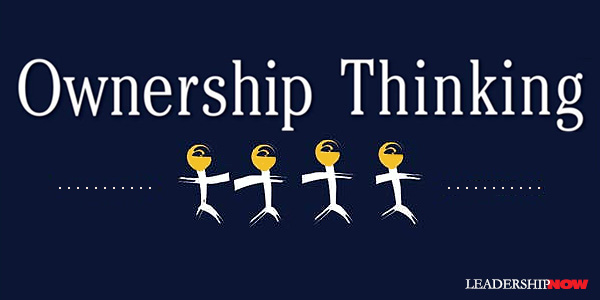
Ownership Thinking is about developing leaders at all levels. “Fundamentally,” writes author Brad Hams, “Ownership Thinking is about moving employees away from the ‘me’ way of thinking and towards concerns of the business and its financial performance.” This is leadership thinking in a business setting. When people understand the business, their role in it, and are informed of what is going on and take responsibility for the outcomes, then they become better stewards of the company’s resources and help to create wealth. Hams has found that the vast majority of people “want to engage and contribute, and feel much better about themselves when they have the opportunity to do so … and they have the capacity to do so.” We often frustrate that effort and create cultures of entitlement because, in the words of Judith Bardwick author of Danger in the Comfort Zone, “managers are unwilling to do the work of requiring work.” Hams says his mission in life is to eradicate habits of entitlement in organizations. People who actually produce things do so primarily for two reasons: (1) They have a strong work ethic. In other words, they have to believe that rewards come only with hard work, and (2) They enjoy producing. It is exciting for them, and the reward for producing is not only the things they are able to afford as a result of it, but the personal growth and sense of worth that come from producing: that is, true self-esteem. A workforce that is helping to create wealth should be able to participate in the wealth they are creating. However, incentive plans should be self-funding, and “it is the obligation of ownership and leadership to teach them how to do that and to provide them with the tools and training necessary to accomplish the task.” Simply put, your employees need to know what’s going on. In a chapter entitled, Your Employees Think You Make Wheelbarrows of Money, Hams relates that when he asks the question: “Your company had 12 million in sales last year, what do you think the profit was?” it is not uncommon to hear 50% from employees of companies where financial information is not shared or business acumen taught. “In the absence of information, people make stuff up.” Generally speaking, the people with the greatest understanding and expertise in any given area are the people who are actually doing the work, and these people are not necessarily management. For an organization to achieve excellence, it must engage all of its organization members. Ownership Thinking is a how-to book. Hams explains how to create incentive plans that work (plans that clearly align employees’ behavior to the organization’s business and financial objectives), how to teach financial skills (how the company makes money and how they add - or take away – value), creating the right performance indicators, rapid improvement plans and how to implement Ownership Thinking for the long-term. “Practicing Ownership Thinking will allow you, as an owner or leader, to rest easier knowing that your employees are making decisions and taking actions that are aligned with what you would do yourself.” 
Posted by Michael McKinney at 10:40 AM
09.09.11

Managing the UnmanageableIf we truly want to deal with a difficult or unmanageable person, we have to get at the thinking behind the behavior. Why do they do that? Why are they that way?Instead of going deeper, it’s easier to just label them and avoid the issue. He’s rude. She’s unreliable. He’s an egomaniac. She’s self-absorbed. Anne Loehr and Jezra Kaye, authors of Managing the Unmanageable, say that these “unmanageable” people are costing companies a fortune. Loehr estimates that her clients lose, on average, 30% of their productivity because of issues related to unmanageable employees. The fact is, “there’s a world of difference between someone who’s acting unmanageable, and someone who can’t [won’t] act any other way. There’s a world of difference between someone who’s become unmanageable in response to a particular set of circumstances (that can, at least theoretically, be changed) and someone who’s just like that.” Perceiving the difference is the task of leaders, managers, and coaches. Most of the time we deal with people at the symptom level. Managing the Unmanageable is written to help you do just that. They begin with an appropriate caution: If you find yourself being convinced that someone could never have the slightest redeeming good quality, find a way to deal with your own feelings before you try to manage theirs. Good advice. There are some early warning signs that it is time to look deeper than the behaviors you see: Diminished Motivation: “Frustration with a job can grow out of unmet or unrealistic expectations, company-wide uncertainty or relationship problems on a team or with a manager.” You’ll hear comments like: “I’m just not into it anymore.”Unclear Expectations: Misunderstandings are common. We don’t always communicate as clearly as we think. Too much often goes unsaid. Sadly, too, “managers and executives sometimes purposely lead employees astray, confuse them, or keep them in the dark to avoid unpleasant issues or consolidate power in their own hands.” It sounds like this: “I have no idea what she wants.”Lack of Confidence or Self-Esteem: “It’s natural to wonder if you have what it takes when the stakes go up or your job becomes more complex. But if that lack of self-confidence persists, an employee can become resistant, defensive, and ultimately unmanageable. They will say things such as: “I don’t know why they thought I could do this.”Personal Issues: “When your employee is distracted, self-absorbed, or unable to focus, her problem may stem from conditions outside of work. It might be expressed as: “I haven’t slept through the night in weeks.”“A radical shift in behavior,” say Loehr and Kaye, “may be your first indication that a good employee is morphing into an unmanageable employee.” In short, other people have many of the same problems we have, it’s just that they haven’t learned how to deal with it or are not in a position to do anything about it in the same way that we would as leaders. The book specifically deals with the excuse-maker, the grumbler, the egomaniac, the loose cannon, the joker, the do-gooder, the wallflower, the gossip, the slacker, the rude-nik, and the AWOL. Each “salvage” operation follows the 5-C Model: Commit or Quit, Communicate, Clarify Goals and Roles, Coach, and Create Accountability. The focus of each chapter is to get behind the behavior of each type and understand it. You will find helpful composite cases, practical tips and dialogues for dealing with each type.
Posted by Michael McKinney at 08:41 AM
09.07.11

The Anywhere Leader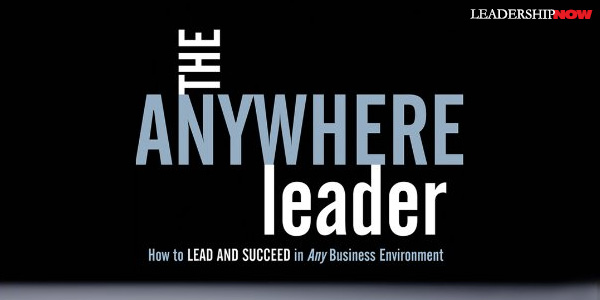
IN an environment of uncertainty and disruption, a successful leader must become what Mike Thompson calls an Anywhere Leader. The anywhere leader is the kind of leader who can land on their feet no matter what the setting or situation presents. Mike Thompson, author of The Anywhere Leader, says that “managers who have advanced their careers through tumultuous times are the ones who find a way to fit in, build trust, and contribute in any setting in which they are placed.” In order to adapt to and broker positive change in any environment, the Anywhere Leader possesses three key traits: Driven for Progress: Driven more by progress than politics. This means that they are discerning, daring, and determined. Because they are driven for progress, they operate with the right and proper motives and remain determined. To become a discerning leader, you need to immerse yourself in a constant state of evaluation…. Because these leaders never view their decisions as static, they aren’t consumed by trying to make the perfect call. They can confidently move forward, knowing that they can, and will, make adjustments as they go. Sensationally Curious: Having an exploratory mindset. They are consummate learners, who continue to grow and improve themselves, their team, and their work. Corollary strengths include being reflective, receptive, and perceptive. Anywhere Leaders have a distinctive ability to go deep with their own personal insights—calling upon their experiences, connecting with them, and forming some pretty strong opinions from them—yet put their egos aside and be open to the opinions of others. These leaders aren’t afraid to shift their thinking. They are in pursuit of the best idea regardless of whether it comes from them or from someone else. Vastly Resourceful: Able to get the most out of whatever you have to work with. Related strengths include being imaginative, inclusive and inventive. Because they are resourceful, they never get stuck in uncertainty, but invent their way through setbacks and out of tough spots. Leaders who can imagine are leaders who don’t get stuck. Thompson devotes a chapter to developing each of these traits. Few have all of these traits in ample amounts but awareness creates an opportunity to develop and/or manage these qualities. Not everyone is cut out to be an Anywhere Leader, nor does everyone need to be, says Thompson. “A job for an Anywhere Leader is one that features uncertainty—the unfamiliar, the unknown, and the unpredictable nature of business.” Thompson suggests that you structure your life so that you are accessible, wired (connected), attuned, and un-nested (MBWA) so that you are transportable or able to lead effectively, anywhere and everywhere you are. 
Posted by Michael McKinney at 10:49 PM
09.05.11

Ones Should be CEOs, Twos Should Not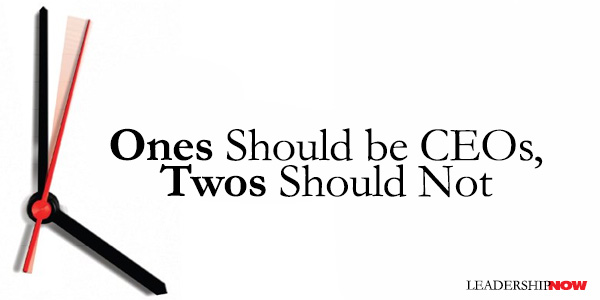
TECHNOLOGY is reaching a breaking point. The amount of data is even overwhelming computing capabilities. A new model of information technology is needed. A new model is being found by applying the predictive nature of the brain to the way computers "think." Wayne Gretzky has famously said, “I skate to where the puck is going to be, not where it has been.” Sports commentators would say that he seemed to be two seconds ahead of everyone else. In The Two-Second Advantage, authors Vivek Ranadivé and Kevin Many write, “Like Gretzky on ice, the most successful people in various fields make continual, accurate predictions just a little ahead of and little better than everybody else.” They don’t need to be able to see ten years out; just enough ahead will do the trick.Part of what is going on in the brain is a function called “chunking.” Predicting and chunking go together by looking for patterns and predicting outcomes. We chunk all types of information. It makes us efficient. If we didn’t chunk, we would think about everything as if it was for the first time. Teaching computers to do this will make them more useful—“two-second-advantage” predictive technology. What caught my attention in their discussion of predictive thinking—from a leadership standpoint—was the idea of two types of leaders found at the top of organizations: Ones and Twos.
Ones tend to be founders. They are bullheaded and courageous. They tell people what to think, not what they think people want to hear. They see openings and get flashes of creativity—like Gretzky in a hockey game. They can take in everything that is happening at a company and see it from a higher level, the details blurring into instinct. Bill Gates is a prototypical one; Steve Ballmer is a two. Steve Jobs is a classic one. The authors say that ones should be CEOs, and twos should not. Of course, a good CEO really needs to be both—and can be with practice—but only rarely do. Of Interest:

Posted by Michael McKinney at 04:57 PM
09.01.11

First Look: Leadership Books for September 2011Here's a look at some of the best leadership books to be released in September.




For bulk orders call 1-800-423-8273  Build your leadership library with these specials on over 120 titles. All titles are at least 40% off the list price and are available only in limited quantities.
Posted by Michael McKinney at 07:50 AM
|
BUILD YOUR KNOWLEDGE


How to Do Your Start-Up Right STRAIGHT TALK FOR START-UPS 
Grow Your Leadership Skills NEW AND UPCOMING LEADERSHIP BOOKS 
Leadership Minute BITE-SIZE CONCEPTS YOU CAN CHEW ON 
Classic Leadership Books BOOKS TO READ BEFORE YOU LEAD |
|